- PLANT MEDICINE
- >
- Tinctures
- >
- MANGO LEAF TINCTURE
MANGO LEAF TINCTURE
Family: Anacardiaceae
Genus: Mangifera
Species: indica
Synonyms: None notable
Common Names: Mango leaf
Parts Used: Leaves
Main Actions: Antidiabetic, antioxidant, hypotensive
Other Actions: Antimicrobial, anti-inflammatory, hepatoprotective
Description: Mango leaves are dark green with a glossy appearance, typically elliptical or lanceolate in shape, and arranged spirally on the branches. They are about 6 to 16 inches in length and 2 to 7 inches in width.
Tribal and Herbal Medicine Uses: Used traditionally in various cultures for managing diabetes, reducing blood pressure, and treating microbial infections.
- Mango leaf tincture is known to help lower blood sugar levels in diabetes patients. It works by stimulating the pancreas to produce more insulin, which helps regulate the blood sugar levels.
- Mango leaf tincture is also said to be effective in reducing high blood pressure. It works by stimulating the kidneys to produce more nitric oxide, which relaxes the blood vessels and lowers the pressure.
- Mango leaf tincture is known to be a natural digestive aid. It helps to improve digestion by increasing the production of digestive enzymes and bile, which helps to break down food more efficiently.
- Mango leaf tincture is also said to be effective in fighting off infections. It has antibacterial and antifungal properties that can help to reduce the risk of infection.
- Mango leaf tincture is also known to boost the immune system. It helps to increase the production of white blood cells, which helps the body fight off infection and other illnesses.
Plant Chemicals: Polyphenols, flavonoids, tannins, triterpenoids
Biological Activities and Clinical Research: Research suggests antidiabetic effects, antioxidant properties, and potential benefits in lowering blood pressure. Some studies indicate antimicrobial and hepatoprotective activities.
Current Practical Uses: Utilized in traditional medicine for managing diabetes, promoting overall health, and addressing microbial infections.
Main Preparation Method: Infusion or decoction of dried mango leaves.
Main Actions (in order): Antidiabetic, antioxidant, hypotensive
Main Uses: Managing diabetes, reducing blood pressure, combating oxidative stress
Properties/Actions Documented by Research: Antidiabetic, antioxidant, hypotensive, antimicrobial, hepatoprotective
Other Properties/Actions Documented by Traditional Use: Anti-inflammatory
Cautions: No significant cautions reported, but excessive use may lead to hypoglycemia in diabetic individuals.
Traditional Preparation: Leaves brewed into tea or incorporated into traditional dishes.
Contraindications: None reported in traditional use; however, caution advised for individuals with hypoglycemia or low blood pressure.
Drug Interactions: None reported, but caution advised when using with medications for diabetes or hypertension, as it may potentiate their effects.
Recommended dosage: 1-2 ml twice daily. Start with the lower dose and gradually increase as needed. It is best to take the tincture with food to help maximize absorption.



